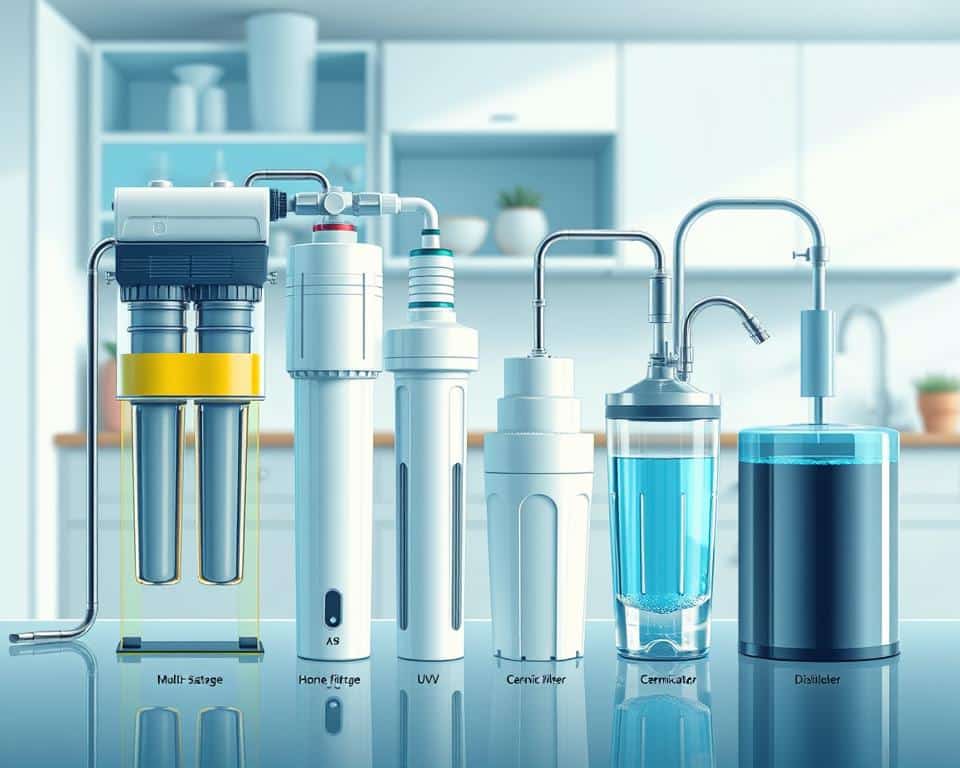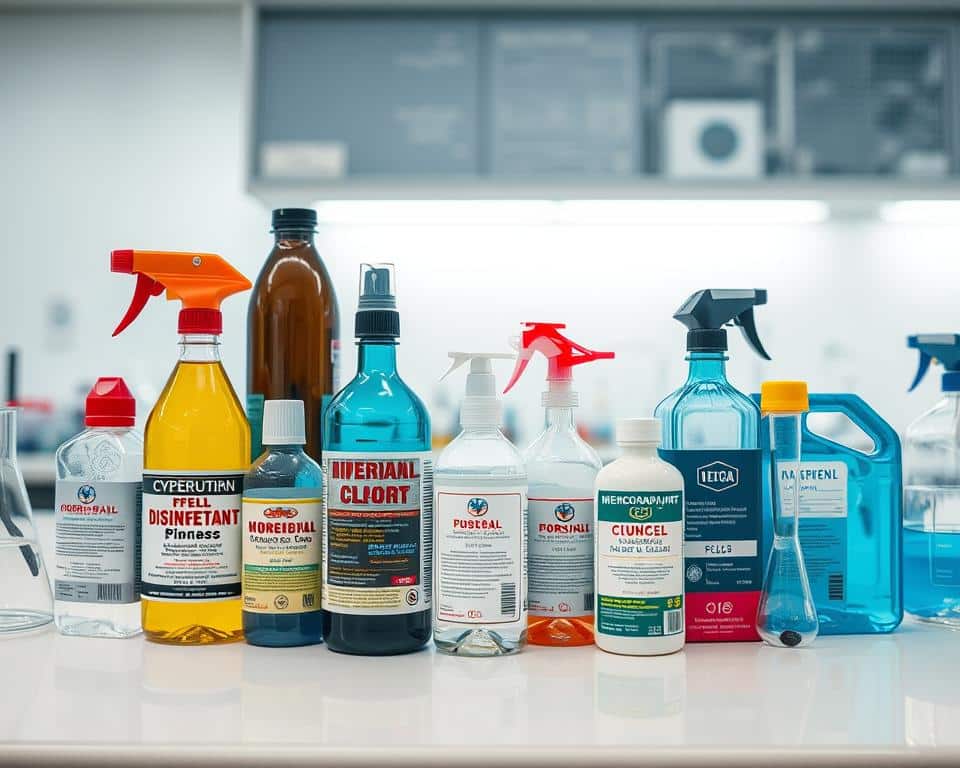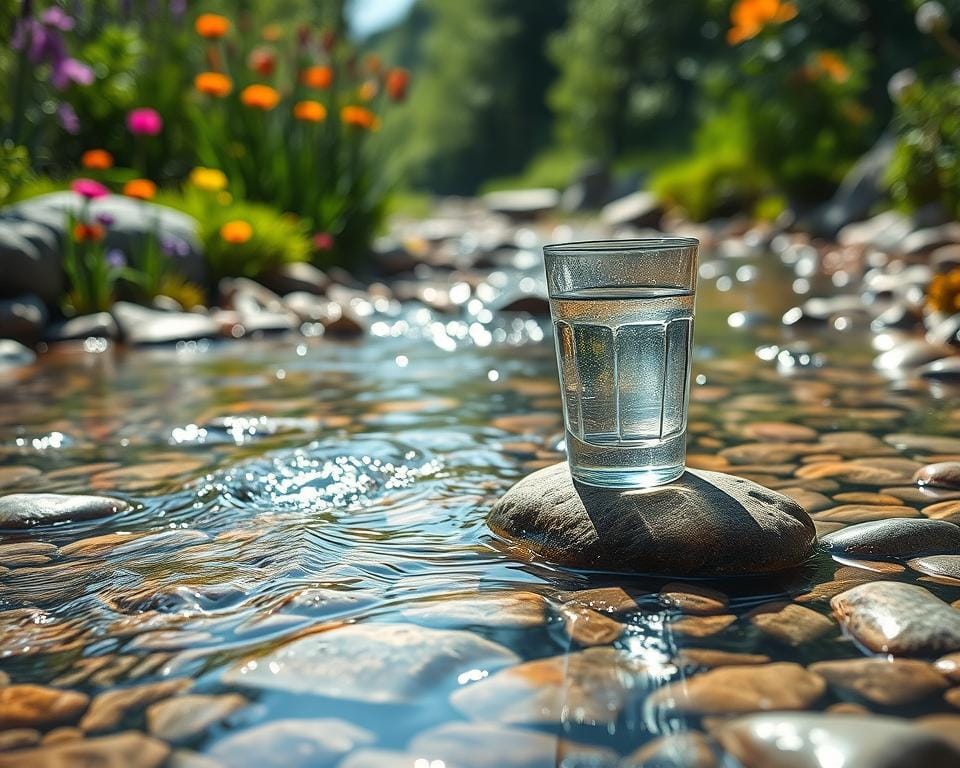Water purification turns dirty water into something safe to drink. It’s important to know about the ways we can clean water. This means whether you’re at home or outdoors, you can have safe water. Here, we’ll talk about five main ways to purify water, including boiling, using filters, adding chemicals, reverse osmosis, and UV treatments.
About 1 in 3 people worldwide don’t have clean drinking water. This is a big problem. Also, in the US, over 100,000 cancer cases are linked to bad stuff in water coming from farms and factories. That’s why it’s so important to have good ways to clean our water.
There are many ways to make water safe, from boiling to reverse osmosis. These methods help homes and factories get clean water. Knowing about these methods can help you stay healthy, whether you’re hiking or just at home.
Boiling: The Traditional Method
Boiling water is a very old and simple way to make water safe. For many years, people have used it when they didn’t have access to modern ways of purifying water.
Process
Boiling water to purify it means heating it until it bubbles vigorously for one minute. In places high up where the air is thinner, you should boil it for three minutes. Boiling removes dangerous bugs, viruses, and other germs that can make people sick.
Advantages and Disadvantages
Boiling water’s big plus is that it kills germs, making water safe in emergencies. You don’t need special chemicals, just heat, which you can find anywhere.
But, boiling can’t get rid of stuff like heavy metals or chemicals. Even after boiling, things like lead and drugs can still be in the water. These things are harmful to health.
Also, boiling water takes time and a lot of energy. It’s not practical if you need a lot of water every day. While modern filters clean water quickly and easily, boiling is better for sudden needs.
Boiling is great when you urgently need clean water. But for cleaning water in the long run, better options exist. These options can remove more types of impurities.
Filtration Systems
Filtration systems are key to clean, safe drinking water. They range from simple to complex. These systems remove harmful substances from water. Activated carbon filters are common and remove chlorine, sediment, and some organic compounds.

Types of Filtration
There are different water filtration systems for various needs:
- Activated Carbon Filters: They remove dust, heavy metals, and organics, making water taste better. They must be replaced regularly to work well.
- Reverse Osmosis: This method produces almost pure water. It’s great for turning seawater into drinking water.
- Mesh Filtration: Perfect for catching sand and dirt, ensuring water looks clean.
Usage in Daily Life
Filtration systems are part of our everyday life. For example, Brita filters and the MSR TrailShot Microfilter are well-known. They remove harmful substances like sand, chlorine, and bacteria. This keeps our drinking water safe and clean.
Maintenance of Filtration Systems
Keeping water filters in good shape is crucial. This includes backflushing and replacing carbon filters as needed. Proper care keeps the system working well and lasts longer. This means always having access to clean water.
Water Purification Systems
Today’s water purification technologies are diverse. They aim to remove harmful substances from water. This makes water safe to drink. Methods include reverse osmosis, UV treatment, and advanced oxidation. These work for homes and big treatment facilities alike.
The water purification process uses high-tech tools and precise controls. Some systems even operate remotely to keep water quality stable. Reverse osmosis, for example, takes out salts, bacteria, and harmful substances. It’s great for turning seawater into drinking water. Although it costs more and uses more energy, it’s becoming popular in areas without standard water treatment.
UV water treatment uses ultraviolet light to kill germs in drinking water. It doesn’t need chemicals to work. Sand filtration is another method. Slow sand filtration gets rid of nearly all bacteria. Rapid sand filtration is a bit less effective but still very good.
| Filtration Method | Bacteria Removal Efficiency | Filtration Rate |
|---|---|---|
| Slow Sand Filtration | 99.8-99.9% | 100-400 L/m²/hr |
| Rapid Sand Filtration | 98-99% | 4000-7500 L/m²/hr |
Water purification is key for many sectors like chemicals, oil, food, and textiles. These areas need clean water for their work. Systems range from small home setups to big plants for cities. To stay reliable and meet environmental laws, these systems are getting smarter. This includes online monitoring, automated control, and SCADA systems.
Improved water systems aim for better energy use and fewer carbon emissions. They also seek to cut down on chemical usage. Renewable energy sources, like solar or wind power, are part of these goals. With 30% of people worldwide lacking clean water, the need for these technologies is huge. They are vital in providing safe water everywhere.
Chemical Treatments for Emergency Use
Chemical treatments like chlorine and iodine are great for emergency water purification. They kill germs and disease-causing organisms. This makes water safe to drink when you can’t use other methods. Knowing how to use them correctly is crucial to avoid health risks.
Chlorine and Iodine
Chlorine treatment is a top method for purifying water in emergencies. It uses household bleach, which contains sodium hypochlorite, to disinfect water. The concentration of sodium hypochlorite in bleach is usually between 5% and 9% in the U.S. For water you plan to store, add 4 to 5 drops of unscented liquid chlorine bleach per gallon. In emergencies, especially with cloudy water, use 16 drops per gallon.
Iodine purification is handy and portable, found in tablets or liquid. It kills most waterborne germs and is a good choice when bleach isn’t an option. Hikers and travelers find iodine tablets very useful for making water safe.

Usage Instructions
Using chlorine and iodine treatments correctly is important to avoid risks. For chlorine, mix 4 to 5 drops of unscented bleach with each gallon of clear water. Stir well and wait 30 minutes before drinking. For cloudy water, increase to 16 drops per gallon.
Use iodine tablets by following the package directions, typically one or two tablets for each quart of water. After adding, stir and wait about 30 minutes. This allows the iodine to work. Both methods ensure safe drinking water in emergencies. Remember to replace stored water every one to two years.
Visit this guide on water treatment to learn more about chemical disinfectants and other ways to purify water.
Disinfection Methods: Chlorination and UV Treatment
Disinfection plays a key role in making water safe by killing harmful microbes. Chlorine disinfection is a popular method. It started in the United States in 1908. While it fights many diseases, it doesn’t catch all germs. For example, cryptosporidium is chlorine-resistant.
Different situations call for different amounts of chlorine. If the water looks clear, a simple chlorine treatment works. But very dirty water might need more than one chlorine treatment. Superchlorination adds lots of chlorine to ensure safety but it must be removed before drinking. Even though it’s affordable and keeps water safe for a long time, chlorine can make water taste and smell bad. It may also cause allergic reactions and create harmful substances.
There’s another way to disinfect water called ultraviolet (UV) water disinfection. It uses UV light to kill bacteria and viruses without using chemicals. This method is fast, taking about 20 to 30 seconds, and it doesn’t change the water’s taste or smell. It’s especially good at killing germs that chlorine can’t.
Choosing between chlorine and UV depends on the water treatment needs. Chlorine is great for treating lots of different waters cheaply. But UV is better for the planet and works against all germs. Some places use both to make sure the water is extra clean.
Here’s a look at chlorine and UV:
| Method | Advantages | Disadvantages |
|---|---|---|
| Chlorine Disinfection | Cost-effective, long-lasting protection, versatile | Taste and odor issues, formation of harmful byproducts, not effective against all microbes |
| Ultraviolet Water Disinfection | Chemical-free, environmentally friendly, effective against chlorine-resistant microorganisms | Higher initial setup cost, requires maintenance of UV lamps, less effective in very cloudy water |
Both chlorine and UV disinfection are key in water purification. They make the water safe and clean for various uses. Whether alone or together, they help in the fight against waterborne germs.
Conclusion
Water purification is crucial for our health. It makes sure we have safe water through different methods. Traditional boiling kills harmful organisms but not chemicals.
Technology like reverse osmosis and UV purifiers add to these methods. Reverse osmosis removes dangerous substances but can be expensive. UV purification gets rid of bacteria and viruses without altering the water’s taste or chemicals.
Using the right purification method is key for clean water everywhere. In cities or rural areas, techniques like bank filtration improve water safety. Keeping up these methods means consistent access to safe water. This helps avoid waterborne diseases and promotes long health.
For tips on recycling water containers, check out this resource. It helps with sustainable water use.

